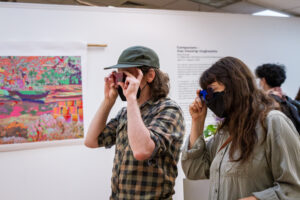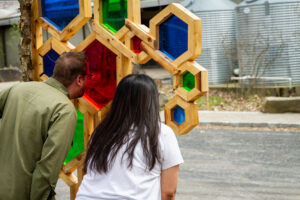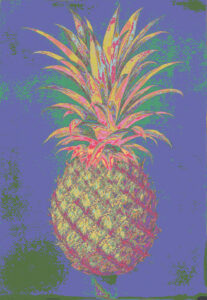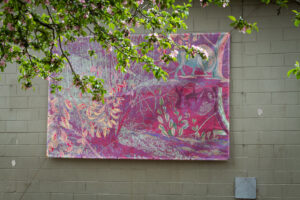
Visitors interacting with artwork by Maria Dumlao, Installation view Companions, Schuylkill Center, 2022. Photographer: Ricky Yanas
Cultures and communities define themselves through food. ‘You are what you eat’ is both an adage about nutrition and a reflection on food as an integral part of our social identity. But what these foods are, in turn, is defined by species that live and grow in our landscapes and by foreign relatives—plants, animals, people—that migrate and travel around the globe.
The Schuylkill Center’s newest art exhibition explores how we, as individuals and as a community, define ourselves at home—through food and companionship. Blending art, ecology and food culture, Companions – mas masarap magkasama (a Filipino phrase that roughly translates to ‘more delicious together’), includes newly commissioned work by Filipino-American artist Maria Dumlao along with Nicky Uy and Omar Buenaventura of the collaborative Bahay215.
Inside the gallery, natural and metaphorical ingredients from botany to commerce are assembled into colorful prints that tell the hidden stories of indigenousness, colonization and food culture between the Philippines and North America. One of them, hanging prominently from a bamboo stick in the gallery, is an enormous print of a pineapple with decorative waxy leaves and its characteristic pattern around the stem. Printed on canvas in Pantone’s tropical color palette, the image seems at first glance overexposed. But activating the image by looking through transparent filters in red, green, and blue – RGB, the colors that make up the visual images we encounter daily on monitors, mobile devices, and digital photography – the filters reveal different stories in shades of white, black and many grays in between. Through the red lens the pineapple appears like a hand-drawn botanical illustration, yet through green the fruit exposes a body filled with cans of SPAM. The pineapple, arguably a symbol of the tropics (from the perspective of American industry, it must be noted), is a major food item in the Pacific Islands. But so is the processed pork meat that during the American annexation of the Philippines the invading colonizers brought to Filipinos’ tables.
Other prints in the exhibition reveal invasive yet edible knotweed spreading over homes, migrating honey bees naturalizing into new landscapes, extinct passenger pigeons swirling over industrialized countrysides (exterminated due to humans hunting them as food), tropical species creeping into our floral home design, and ships carrying goods (look out for the mermaid) around the globe. The prints set the stage for a dialogue about our understanding of landscape diversity as we cultivate plants and creatures for the global economy and food market. Who is welcomed and who is excluded? When does a migrant become native to their new home?
Making yourself at home is an intimate desire of all species, as illustrated by the exhibition’s outdoor installations. Two of Dumlao’s large-scale prints, mounted on the outside of the Visitor Center, are accompanied by bamboo structures that are loosely inspired by the concept of a bahayan kubo, a stilt house original to the farmed fields of the Philippines. The Tahanan (Filipino for intimate bahay) and pugad (Filipino for hive) open up colorful views into our changing landscape.
Companions afifrms a point made by celebrated ecologist Robin Wall Kimmerer, who notes that growing together as species in an environment is a reciprocal matter of beauty as well as of ecology. For example, when purple Hyssop is brightly flowering next to yellow Yarrow (check out native plants displayed in the gallery), these edible herbs do more than simply attract pollinators for their own survival. Their complementary colors are the art of brilliant companionship.
“My work serves as a connective tissue,” explains Maria Dumlao, “embracing the histories lived, both documented and undocumented.” Companions aims to spark conversations about the migratory paths of plants and people and open our eyes to the delicious fascination of nature. Unfolding the hidden and untold stories of the displaced, the exhibition is a contribution to combating ongoing sentiments against Asian American communities as we enter Asian American and Pacific Islander Heritage month in May. Let nature’s beauty be the entrance point for us to reconsider our perception of today’s land, people and interrelationships.
Companions is open until August 6, 2022 at the Schuylkill Center. Look for summer programming for the whole family around foraging, food stories and art making. Learn more about the exhibition online and about edible native plants through the Center’s native plant sale.

Visitors interacting with installation by Maria Dumlao and Bahay2015, Installation view Companions, Schuylkill Center, 2022. Photographer: Ricky Yanas
By Tina Plokarz, Director of Environmental Art


